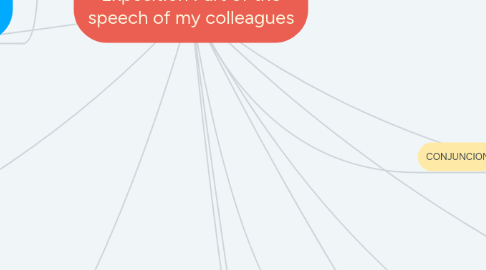Exposition Part of the speech of my colleagues
by Cindy Vanesa londoño Alvarez

1. Examples Stop! - Used as an imperative pause call. Ay !: is used to express a living feeling. Eh !: it is used to ask, call, despise, reprimand or warn. Hello !: is used as a conversation opening salutation. Hey !: It is used as an opening expression to call a person.
2. La interjección es una clase de palabras de las lenguas naturales que no constituye una parte de la oración *Expresa Algeria *Yeah! / ¡Sí! Ejemplo: Yeah! I got the job. / ¡Sí! Conseguí el trabajo. *Para callar a alguien *Shh. Ejemplo: Shh, don’t talk during the movie. / Shh, no hablen durante la película.
3. EXAMPLES (EJEMPLOS) With a noun: / Con un sustantivo * I am a teacher.(Soy profesor.) * You aren’t a student.( No eres estudiante.) * Is he a doctor?( Él es médico?)
4. VERBS
4.1. Verbs are words that indicate actions, existence (being / being), possession (having) or encouragement. Los verbos son palabras que indican acciones, existencia (ser/estar), posesión (tener) o ánimo Some of the most common verbs in English: Algunos de los verbos más comunes en inglés *to be(ser/estar) * to have(tener/haber) * to do(hacer) * to make(hacer) * to take(tomar/coger) * to get(conseguir) * to go(ir)
5. PREPOSICIONES
5.1. ¿WHAT ARE PREPOSITIONS IN ENGLISH? Prepositions in English are one or more parts of the sentence that join words denoting the relationship they have with each other. PREPOSICIONES ANTES DEL VERBO Ejemplo: No debería irme de Nueva York sin visitar el Puente de Washington / No debería irme de Nueva York sin hacer esto *After – Después I’ll go to your house after dinner -Iré a tu casa después de cenar *Behind – Detrás He was behind the -Él estaba tras la puerta *Since – Desde: He hasn’t slept since yesterday : Él no ha dormido desde ayer
6. interjection
7. What is adjective? It is a class of word or part of the sentence that qualifies the noun, and that provides additional information or complements its meaning. The adjective is placed before or after the noun, agreeing on gender and number.
8. Prayers 1. Donald, our boss, is richer than your father. (Donald, nuestro jefe, es más rico que tu padre) 2. My aunt, Laura, is a great woman. (Mi tía Laura, es una gran mujer) 3. It is something very unusual. (Es algo muy inusual) 4. Paris is famous for its traditional culture. (París es famosa por su tradicional cultura) 5. My father is the most generous. (Mi padre es el más generoso)
9. son palabras que reemplazan a un sustantivo o nombre (asumiendo todas sus funciones) por lo tanto designan a personas, animales o cosas mediante cualquiera de las tres personas gramaticales Pronombres personales y pronombresacusativos: Son aquellos que se utilizan para sustituir un antecedente (ya seauna persona, una frase, un objeto, es decir, un sustantivo) Ejemplo: I Love you Lucy and she loves me
10. ¿QUÉ ES UN SUSTANTIVO? . Palabra que sirve para designar los seres vivos o las cosas materiales o mentales; gramaticalmente funciona como núcleo de un sintagma nominal, y varía en cuanto al género y al número. . Examples: *The glasses are in the kitchen. (Las gafas están en la cocina) *The churches are near. (Las iglesias están cerca) *The buses are at the corner. (Los autobuses están en la esquina) *The watches are new. (Los relojes son nuevos) *The dishes are broken. (Los platos están rotos) *The boxes are empty. (Las cajas están vacías)
11. ¿TIPOS DE SUSTANTIVOS? . GENERO: El género cuando se trata de personas coincide con el sexo. Masculino: Son palabras que designan una entidad masculina Palabras: boy, man, lion, actor -the bull gets very angry with the color red -the stag is very scared femenino: son palabras que hacen referencia le genero femenino. Palabras: cow, woman, girl, waitress, queen -my daughter is very intelligent -I am the hostess of this event Neutral: se aplica a los sustantivos que sirven para los dos géneros. palabras: Teacher, a Child, a Friend, He She It. ... Waiter, waitress, Hero, heroine, King- Queen, Husband-Wife -the police officer are in the police station -the sibling are very gossipy
12. Las conjunciones son empleadas para enlazar entre sí las palabras y/o oraciones. Hay dos tipos de conjunciones y la posición que tiene dentro de una oración depende del tipo. Además, hay tres formas de conjunciones. Las conjunciones más comunes son “and,” “but” y “or” Ejemplos: ° She works at a bank and goes to university.(Trabaja en un banco y va a la universidad.) Tipos de conjuciones : Conjunciones coordinantes: Este tipo de conjunción se utiliza cuando queremos enlazar dos frases que tienen el mismo valor. Ejemplo: She likes to sing and dance.(Le gusta cantar y bailar.)
12.1. Conjunciones subordinantes: Se utiliza este tipo de conjunción cuando una de las frases depende de la otra (frase subordinada). Ejemplos :I have been working at the bank since 2005.(Llevo trabajando en el banco desde 2005.)
13. Pronoun
14. CONJUNCIONES
15. Adjective
16. NOUNS


